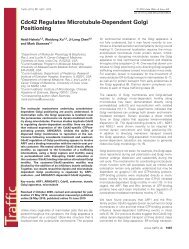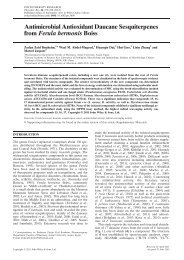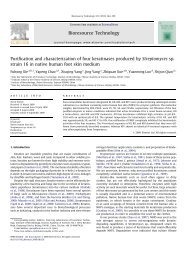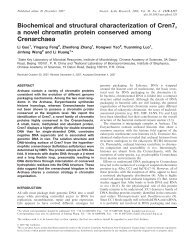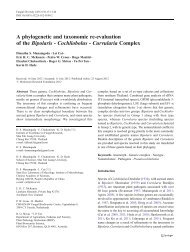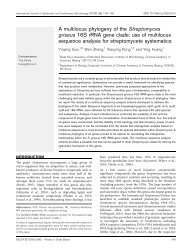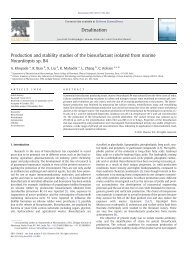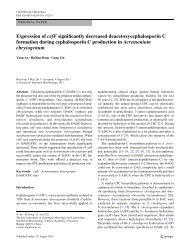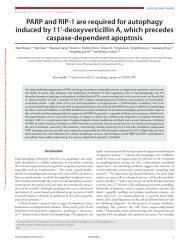Structure and Cleavage Specificity of the Chymotrypsin-Like Serine ...
Structure and Cleavage Specificity of the Chymotrypsin-Like Serine ...
Structure and Cleavage Specificity of the Chymotrypsin-Like Serine ...
You also want an ePaper? Increase the reach of your titles
YUMPU automatically turns print PDFs into web optimized ePapers that Google loves.
ARTICLE IN PRESS<br />
14 <strong>Structure</strong> <strong>and</strong> Characterization <strong>of</strong> PRRSV 3CLSP<br />
Table 3. Primers used in this study<br />
Primer Restriction site Nucleic acid sequence (5′–3′)<br />
3CL-F2 SmalI cccgggGCGCTTTCAGAACTCAAAA<br />
3CL-R2 XhoI CCGctcgagTTATTCCAGTTCGGGTTTGGC<br />
3CLM-F1 None TGGCGATGCTGGATCCC<br />
3CLM-R1 None GGGATCCAGCATCGCCA<br />
3CL-EA-F1 NdeI CGCcatatgGGCGCTTTCAGAACTCAAAA<br />
3CL-EA-R1 XhoI CCGctcgagCAGATCCTCTTCTGAGATGAGTTTTTGTTC<br />
AAGTTGAACTGTGGAAAGGCCTCCTTCCAGTTCGGGTTTGGC<br />
Primers used in this study. Noncapitalized letters indicate <strong>the</strong> sequence <strong>of</strong> <strong>the</strong> restriction site inserted. Bold letters indicate nucleotide<br />
changes introduced. Italic letters represent <strong>the</strong> sequence encoding <strong>the</strong> Myc epitope. Underlined letters represent <strong>the</strong> coding sequence <strong>of</strong><br />
<strong>the</strong> eight N-terminal residues <strong>of</strong> nsp5.<br />
reverse transcription-PCR reaction from <strong>the</strong> genomic RNA<br />
extracts <strong>of</strong> PRRSV isolate (GenBank accession no.<br />
EF112445) <strong>and</strong> <strong>the</strong>n inserted into SmaI <strong>and</strong> XhoI sites <strong>of</strong><br />
pGEX-6P-1 to yield plasmid pGEX-3CL. The S118A<br />
(Ser118 substituted by Ala) mutant construct was<br />
achieved by overlapping extension PCR. Using pGEX-<br />
3CL as template, with primer combinations <strong>of</strong> 3CL-F2/<br />
3CLM-R1 or 3CLM-F1/3CL-R2, two segments were<br />
obtained first <strong>and</strong> <strong>the</strong>n <strong>the</strong>y were mixed toge<strong>the</strong>r at<br />
equal molar ratio as new templates in a second round <strong>of</strong><br />
PCR by primer pairs 3CL-F2/3CL-R2. The resultant<br />
fragment that carries <strong>the</strong> S118A substitution was inserted<br />
into pGEX-6P-1 to generate pGEX-3CLM-S118A.<br />
With primer pairs 3CL-EA-F1/3CL-EA-R1, using ei<strong>the</strong>r<br />
pGEX-3CL or pGEX-3CLM-S118A as template, DNA<br />
fragments encoding translational fusion proteins hisnsp4-[nsp4/nsp5]-Myc-his<br />
<strong>and</strong> his-nsp4(S118A)-[nsp4/<br />
nsp5]-Myc-his were amplified respectively. The fragments<br />
were introduced into <strong>the</strong> pET-28b plasmid to create pET-<br />
3CL-EA <strong>and</strong> pET-3CL-S118A-EA (Fig. 1b).<br />
All <strong>the</strong> constructs were verified by direct DNA<br />
sequencing, <strong>and</strong> <strong>the</strong> sequences <strong>of</strong> <strong>the</strong> primers used in<br />
this study are listed in Table 3.<br />
Protein purification <strong>and</strong> cystallization<br />
The detailed production <strong>and</strong> purification procedure for<br />
<strong>the</strong> wild-type 3CLSP have been described previously. 16<br />
For <strong>the</strong> mutant enzyme, <strong>the</strong> same method was adopted. In<br />
brief, 1 μl <strong>of</strong> <strong>the</strong> plasmid was transformed into E. coli BL21<br />
(DE3) competent cells for protein expression. The resultant<br />
GST fusion protein was purified by glutathione-Sepharose<br />
chromatography, cleaved with PreScission Protease, <strong>and</strong><br />
<strong>the</strong> recombinant protein was fur<strong>the</strong>r purified by sizeexclusion<br />
chromatography.<br />
SeMet-labeled 3CLSP was produced in BL21 (DE3) E.<br />
coli grown in SeMet minimal medium (0.65% YNB, 5%<br />
glucose, <strong>and</strong> 1 mM MgSO 4 in M9 medium) supplemented<br />
with L-SeMet at 60 mg L − 1 ; lysine, threonine, <strong>and</strong><br />
phenylalanine at 100 mg L − 1 ; <strong>and</strong> leucine, isoleucine,<br />
<strong>and</strong> valine at 50 mg L − 1 . 54 The expressed protein was<br />
purified as described above.<br />
The purified proteins were concentrated, <strong>and</strong> <strong>the</strong>ir<br />
concentration was determined using BCA Protein<br />
Assay Kit (Pierce) according to <strong>the</strong> manufacturer's<br />
instructions.<br />
Crystallization conditions were optimized, <strong>and</strong> <strong>the</strong> best<br />
crystals for both <strong>the</strong> wild-type <strong>and</strong> SeMet-labeled 3CLSP<br />
were obtained by vapor diffusion in hanging drops<br />
consisting <strong>of</strong> 1 μl <strong>of</strong> reservoir solution (0.1 M sodium<br />
citrate, pH 5.3, <strong>and</strong> 0.7 M monobasic ammonium<br />
phosphate) <strong>and</strong> 1 μl <strong>of</strong> concentrated protein solution<br />
(12 mg ml − 1 in 10 mM Tris–HCl <strong>and</strong> 10 mM NaCl, pH 8.0),<br />
followed by incubation at 18 °C for 7 days.<br />
For <strong>the</strong> S118A mutant protein, <strong>the</strong> crystals were<br />
obtained under conditions similar to those for <strong>the</strong> wildtype<br />
3CLSP, except that <strong>the</strong> pH value was elevated to 5.7<br />
<strong>and</strong> <strong>the</strong> concentration <strong>of</strong> <strong>the</strong> mutant protein was 18 mg/<br />
ml. Crystals appeared after 10 days at 18 °C.<br />
Data collection, phasing, <strong>and</strong> refinement<br />
Crystals were flash-cooled in liquid nitrogen in<br />
cryoprotectant solution containing 15% glycerol <strong>and</strong><br />
50% reservoir solution. Multiwavelength X-ray diffraction<br />
data to 1.9 Å were collected from crystals <strong>of</strong> SeMetlabeled<br />
protein on beamline 3W1B <strong>of</strong> <strong>the</strong> Beijing<br />
Synchrotron Radiation Facility <strong>and</strong> processed with <strong>the</strong><br />
HKL2000 suite <strong>of</strong> programs. Two selenium sites were<br />
located from data collected at peak <strong>and</strong> remote wavelengths<br />
using SOLVE. 17 An initial model was built using<br />
RESOLVE 55 followed by model refinement using<br />
REFMAC5 (CCP4 suite). 56<br />
X-ray diffraction data collected from crystals <strong>of</strong> <strong>the</strong><br />
native protein on an in-house Rigaku MicroMax007<br />
rotating-anode X-ray generator were phased using MR<br />
procedures in MOLREP as implemented in CCP4 Version<br />
6.02. The initially determined structure was used as a<br />
search model. A series <strong>of</strong> iterative cycles <strong>of</strong> manual<br />
rebuilding were carried out in Coot <strong>and</strong> refinement with<br />
REFMAC5 (CCP4 suite). 56<br />
The S118A mutant structure was solved by MR method<br />
using <strong>the</strong> wild-type structure as <strong>the</strong> search model <strong>and</strong><br />
refined to 2.0 Å.<br />
The final statistics are summarized in Table 1. During <strong>the</strong><br />
course <strong>of</strong> model building <strong>and</strong> refinement, <strong>the</strong> stereochemistry<br />
<strong>of</strong> <strong>the</strong> structures was checked by PROCHECK. 18 All<br />
figures were generated using PyMOL 57 <strong>and</strong> ESPript. 58<br />
In vitro peptide trans cleavage assay<br />
The 16-mer substrate peptides (representing eight<br />
putative cleavage sites in PRRSV pp1a or pp1ab) for <strong>the</strong><br />
in vitro 3CL protease peptide cleavage assay were<br />
purchased from Beijing Scilight Biotechnology Ltd. Co.<br />
Each peptide was dissolved in 100% dimethyl sulfoxide at<br />
a concentration <strong>of</strong> 50 mM <strong>and</strong> stored at −80 °C. The nsp4<br />
activity assay was performed in a reaction volume <strong>of</strong><br />
200 μl, using 5 μl nsp4 (or S118A mutant nsp4) (25 mg/ml)<br />
<strong>and</strong> 1 μl peptide (50 mM) in <strong>the</strong> reaction buffer (20 mM<br />
Tris, pH 7.4, 150 mM NaCl, 1 mM ethylenediaminetetraacetic<br />
acid, 1 mM DTT, <strong>and</strong> 10% glycerol) to yield a<br />
final concentration <strong>of</strong> 25 μM enzyme <strong>and</strong> 250 μM peptide<br />
in <strong>the</strong> assay. <strong>Cleavage</strong> reactions were routinely incubated<br />
at 37 °C for 15 h. The reactions were terminated by <strong>the</strong><br />
addition <strong>of</strong> an equal volume <strong>of</strong> 2% trifluoroacetic acid, <strong>and</strong><br />
samples were frozen in liquid nitrogen immediately<br />
Please cite this article as: Tian, X., et al., <strong>Structure</strong> <strong>and</strong> <strong>Cleavage</strong> <strong>Specificity</strong> <strong>of</strong> <strong>the</strong> <strong>Chymotrypsin</strong>-<strong>Like</strong> <strong>Serine</strong> Protease (3CLSP/nsp4)<br />
<strong>of</strong> Porcine Reproductive <strong>and</strong> Respiratory Syndrome Virus (PRRSV), J. Mol. Biol. (2009), doi:10.1016/j.jmb.2009.07.062





